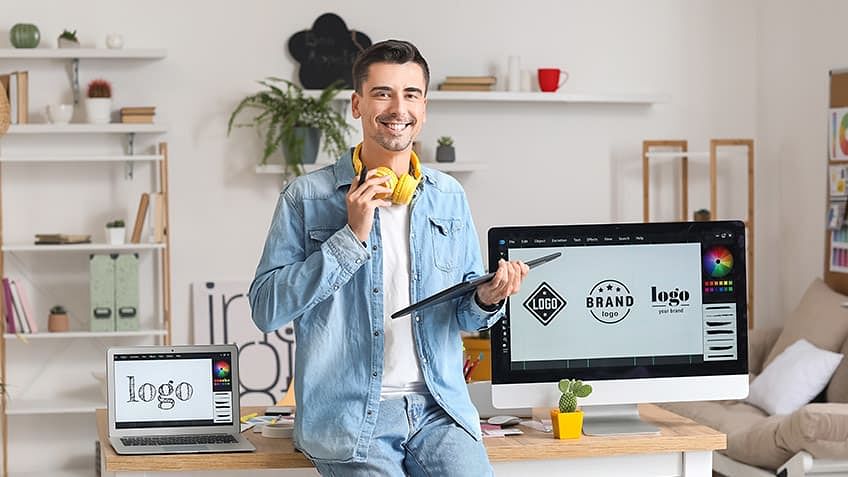Are you interested in becoming a Graphic Designer in 2023? Don’t know from where to start?
If so, you’ve come to the right place!
My Graphic Designer career guide is intended to help you take the first steps toward a career in graphic design. I will provide you with the essential steps, skills, and resources to help you embark on a successful career as a graphic designer.
Whether you’re a beginner or have some experience in the graphic design field, this guide will provide you with the knowledge, skills, and resources you need to begin & succeed.
So, let’s dive in and explore the exciting journey of becoming a graphic designer in 2023!
>> BONUS: How To Become A Software Developer In 2023: Step By Step Guide
Why pursue a graphic design Career in 2023?

Consider pursuing a graphic design career in 2023 for several reasons. It offers creative expression and opportunities in diverse industries. Graphic design has a real-world impact, enhancing brand identities and effectively communicating messages. Skills are transferable to related professions like UX/UI design and web development.
How much do graphic designers make?
The growing digital presence creates a demand for graphic designers. The median annual salary for graphic designers is $50,710, or $24.38 per hour, according to the BLS. Higher pay can be expected in the advertising and public relations sector.
What is graphic design?
Graphic design is the art of visually communicating messages through elements like typography, images, and colors. Designers use their skills to create visuals for print, digital, and multimedia platforms. They collaborate with clients and teams to understand project goals and create visually captivating solutions.
Graphic design is essential for branding, advertising, and marketing, encompassing logos, brochures, packaging, websites, and more. Designers apply principles like balance, hierarchy, contrast, and alignment to craft visually appealing designs with impact. It’s a creative discipline that combines aesthetics and effective communication in various mediums.
What does a graphic designer do?

A graphic designer is a professional who combines artistic and technical skills to create visual designs that communicate messages, ideas, or information effectively. They work on a wide range of projects across various mediums, including print, digital, and multimedia platforms. Here are some key responsibilities and tasks of a graphic designer:
Graphic Designer: Roles & Responsibilities
Visual Communication
Graphic designers use their creativity and design expertise to visually communicate ideas, concepts, or information. They collaborate with clients, stakeholders, or creative teams to understand the purpose and objectives of a project and then develop visual solutions that effectively convey the intended message.
Design Creation
Graphic designers create designs using a combination of elements such as typography, images, illustrations, colors, and layout techniques. They utilize design principles like balance, hierarchy, contrast, and alignment to ensure visual harmony and readability in their designs.
Branding and Identity
Graphic designers play a crucial role in creating and maintaining brand identities. They design logos, brand guidelines, and other visual elements that represent a company or organization’s identity and help establish its visual presence in the market.
Print Design
Graphic designers work on various print materials such as brochures, posters, business cards, packaging, magazines, and more. They consider factors like print specifications, color profiles, and production techniques to ensure high-quality output.
Image Editing and Manipulation
Graphic designers often work with image editing software to retouch and enhance photographs, adjust colors, and manipulate images to fit design requirements.
Collaboration and Communication
Graphic designers collaborate with clients, fellow designers, copywriters, and other professionals involved in a project. They communicate design concepts, present their work, incorporate feedback, and make revisions to ensure the final design meets the client’s needs and objectives.
Keeping Up with Trends
Graphic designers stay updated with current design trends, software tools, and industry practices. They continuously expand their skills and knowledge to adapt to the evolving design landscape and meet the demands of clients and projects.
Graphic Designer: Skills & Qualifications
Creativity & Think outside he box
Graphic designers need a strong sense of creativity to develop original and visually appealing designs. They should have the ability to think outside the box, generate unique ideas, and bring their creative vision to life through their designs.
Understand Design Principles
A solid understanding of design principles is crucial for graphic designers. This includes knowledge of composition, color theory, typography, balance, contrast, and other design fundamentals. Understanding these principles helps create visually harmonious and effective designs.
Software Proficiency
Graphic designers should be proficient in graphic design software tools such as Adobe Creative Suite (Photoshop, Illustrator, InDesign), Sketch, or other industry-standard software. They need to have a good command of these tools to create and manipulate visual elements effectively.
Understand Typography
Typography plays a significant role in graphic design. Graphic designers should have a good understanding of different fonts, their characteristics, and how to use typography to enhance the readability and visual impact of their designs.
Communication Skills
Effective communication skills are essential for graphic designers. They need to be able to understand client briefs, collaborate with team members, and present their design concepts and ideas clearly and persuasively.
Attention to Detail
Graphic designers must pay close attention to detail to ensure accuracy and precision in their designs. They need to be meticulous in their work, ensuring proper alignment, consistency, and error-free output.
Time Management
Graphic designers often work on multiple projects with tight deadlines. Having strong time management skills helps them prioritize tasks, meet deadlines, and deliver high-quality work within the given time frame.
Adaptability
The graphic design industry is constantly evolving, with new trends and technologies emerging regularly. Graphic designers should be adaptable and willing to learn and incorporate new techniques and tools into their workflow.
Strong Portfolio
A strong portfolio showcasing your design skills and previous work is crucial in the graphic design field. It demonstrates your capabilities and gives potential clients or employers an idea of your style, creativity, and expertise.
Education or Degree
While a formal education is not always a requirement, many employers prefer candidates with a degree or certification in graphic design or a related field. A degree program can provide a comprehensive understanding of design principles, software proficiency, and opportunities for portfolio development.
Where Do Graphic Designers Work?
Graphic designers work in various industries and settings, depending on their specialization and career goals. Here are some common places where graphic designers work:
- Design Agencies: Many graphic designers work in design agencies or studios. These agencies cater to a wide range of clients and projects, providing graphic design services for branding, marketing campaigns, print materials, digital designs, and more. Design agencies offer opportunities to collaborate with a diverse team of designers and work on projects for different industries.
- Advertising and Marketing Agencies: Graphic designers are an integral part of advertising and marketing agencies. They work on creating visual materials for advertising campaigns, promotional materials, digital marketing assets, social media graphics, and more. These agencies often have a fast-paced and dynamic environment with a focus on creating compelling designs to attract and engage audiences.
- Freelancing: Many graphic designers choose to work as freelancers or start their own design businesses. They have the freedom to work on a variety of projects, collaborate with different clients, and set their own schedule and rates. Freelancing allows graphic designers to have more control over their work and client selection, but it also requires self-promotion, project management skills, and the ability to handle multiple clients simultaneously.
- Publishing and Media
- Web and Digital Design
- Education and Non-Profit Organizations etc
Step By Step Guide To Become A Graphic Designer
If you want to start a career in graphic design, follow these steps to make your process easier:
1. Acquire necessary skills and knowledge
Graphic design requires a combination of artistic talent, creativity, and technical skills. Start by developing your artistic abilities, understanding color theory, typography, composition, and visual communication.
Familiarize yourself with design software such as Adobe Creative Suite (including Photoshop, Illustrator, and InDesign) commonly used in the industry.
2. Earn a degree or acquire formal education
While a degree is not always a requirement, it can enhance your chances of finding employment and provide a solid foundation in design principles. Consider pursuing a bachelor’s degree in graphic design, visual communication, or a related field.
>> Pro Tip: Best Bachelor Degrees in Graphic Design 2023
Alternatively, you can enroll in design programs, vocational courses, or online platforms that offer graphic design courses.
>> Pro Tip: Best Graphic Design Courses & Certifications [2023]
3. Build a portfolio
As a graphic designer, your portfolio is crucial for showcasing your skills and creativity to potential employers or clients. Start building your portfolio by working on personal projects, freelance gigs, or internships. Include a diverse range of design work, such as branding, print materials, digital designs, illustrations, or any other relevant projects that demonstrate your abilities.
>> Pro Tip: The 14 Best Graphic Design Portfolios (Get an Idea to create your portfolio)
4. Gain practical experience
Seek opportunities to gain practical experience in the field. Consider internships, entry-level positions, or freelance projects to develop your skills and industry knowledge. Real-world experience will help you understand client expectations, project management, and collaboration with other professionals in the industry.
>> Pro Tip: 17 Best Freelance Graphic Design Websites
5. Stay Updated with Design Trends
Graphic design is an ever-evolving field, so it’s important to stay current with the latest design trends, software updates, and emerging technologies. Attend design conferences, workshops, webinars, and join design communities to stay connected with other professionals and learn from their experiences.
>> Pro Tip: Follow Behance & Dribbble more often.
6. Network and seek mentorship
Networking is essential in the design industry. Connect with other graphic designers, attend industry events, join online forums or social media groups related to design. Networking can lead to job opportunities, collaborations, and valuable insights. Consider finding a mentor who can provide guidance, feedback, and industry advice.
>> Pro Tip: Join Graphic Design Communities & Groups
7. Develop a professional presence
Create an online presence to showcase your work and increase your visibility. Build a professional website or create profiles on platforms like Behance, Dribbble, or LinkedIn to share your portfolio and connect with potential clients or employers. Maintain a professional and cohesive online presence that reflects your design style and expertise.
>> Pro Tip: Show case your designs at Behance or Dribbble or both (better).
How to Become a Freelance Graphic Designer?
To pursue a career as a freelance graphic designer, simply follow the guide I’ve outlined above. Once you’ve acquired the necessary skills, you can explore freelance platforms and work as a graphic designer on a freelance basis.
Freelance graphic design offers several benefits that make it an attractive career choice for many designers. Firstly, freelancing provides the opportunity for greater flexibility and control over your work. As a freelance graphic designer, you have the freedom to choose the projects you want to work on, set your own schedule, and determine your rates. This flexibility allows you to tailor your work to your preferences and lifestyle, making it easier to achieve a work-life balance and pursue personal interests alongside your design career.
Another significant benefit of freelancing is the potential for increased earning potential. As a freelancer, you have the ability to set your rates and negotiate fees directly with clients. With experience and a strong portfolio, you can command higher rates for your services. Additionally, as you establish your reputation and client base, you can take on multiple projects simultaneously, further increasing your income potential. Moreover, freelancing eliminates the need for a middleman or agency, allowing you to retain a larger portion of your earnings.
>> Pro Tip: 10 best freelance graphic design websites to find work 2023
Job Opportunities As A Graphic Designer
As a graphic designer, there are various job opportunities available in different industries and sectors. Here are some examples of job opportunities as a graphic designer:
- In-house designer: Work with internal teams, providing design support for marketing, branding, and packaging.
- Advertising agencies: Collaborate on visual content for campaigns, social media, and diverse clients.
- Web and mobile design: Create user-friendly interfaces, websites, apps, and game designs.
- Print and publication: Design layouts for books, magazines, newspapers, brochures, and more.
- Freelancing: Enjoy independence, choose clients and projects, and find opportunities through online platforms.
Graphic Designer Salaries
Graphic designer salaries can vary depending on factors such as experience, location, industry, and skill level. According to the U.S. Bureau of Labor Statistics (BLS), the median annual wage for graphic designers was $53,380 as of May 2020. It’s important to note that salaries can differ significantly based on the designer’s level of expertise and the specific market conditions in each country or region.
Graphic Designer Salaries by Country
Here is a list of average graphic designer salaries by country:
- United States: $54,435 USD
- Ireland: $44,187 USD
- Australia: $43,344 USD
- Finland: $39,311 USD
- Canada: $38,278 USD
- Romania: $36,524 USD .
- Austria: $35,518 USD
- United Kingdom: $35,368 USD
- New Zealand: $33,763 USD
- Hong Kong: $31,000 USD
Frequently Asked Questions About Becoming A Graphic Designer
What does a graphic designer do?
A graphic designer creates visuals using various means of technology, combining art and technology to produce distinctive visuals for clients and companies. Their work includes developing visual assets for marketing campaigns, designing graphics for social media posts, creating layouts for print ads, designing company logos, and retouching photos for digital signage.
Graphic designers can work with print or digital media, and they are found in various industries and settings such as ad agencies, web design firms, marketing firms, and non-profit organizations.What skills are needed to become a graphic designer?
To become a graphic designer, it’s beneficial to have natural creativity and a good eye for visually compelling design. Some key skills to nurture include audience targeting, color theory, typography, layout design, software proficiency (such as Adobe Creative Suite), understanding design principles, and staying updated with design trends and technology.
What are some graphic design interview questions?
During a graphic design interview, you may be asked questions that assess your commitment to learning, familiarity with design concepts, creativity, critical thinking skills, openness to feedback and collaboration, and ability to meet project deadlines. Examples of interview questions include:
If you had to revamp our brand, what changes would you make and why?
Can you describe a challenging design project you worked on and how you overcame it?
How do you handle feedback and criticism?
What design software and tools do you prefer and why?
How do you stay updated with current design trends?
Conclusion
I’ve provided simple steps for starting a career in graphic design. These tips apply to beginners, freelance, agency, and in-house designers. For more inspiration, check our design tips and examples. We hope these tools help you begin your journey.
Remember, this guide serves as a starting point, and your determination, passion, and commitment will be the driving forces behind your success. Best of luck on your journey to becoming a highly skilled and sought-after graphic designer!
Michael Diasz Kirindage



